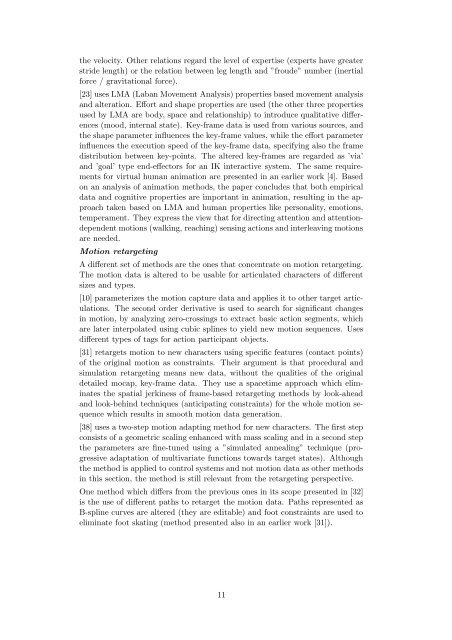Computer Animation for Articulated 3D Characters
Computer Animation for Articulated 3D Characters
Computer Animation for Articulated 3D Characters
Create successful ePaper yourself
Turn your PDF publications into a flip-book with our unique Google optimized e-Paper software.
the velocity. Other relations regard the level of expertise (experts have greater<br />
stride length) or the relation between leg length and ”froude” number (inertial<br />
<strong>for</strong>ce / gravitational <strong>for</strong>ce).<br />
[23] uses LMA (Laban Movement Analysis) properties based movement analysis<br />
and alteration. Ef<strong>for</strong>t and shape properties are used (the other three properties<br />
used by LMA are body, space and relationship) to introduce qualitative differences<br />
(mood, internal state). Key-frame data is used from various sources, and<br />
the shape parameter influences the key-frame values, while the ef<strong>for</strong>t parameter<br />
influences the execution speed of the key-frame data, specifying also the frame<br />
distribution between key-points. The altered key-frames are regarded as ’via’<br />
and ’goal’ type end-effectors <strong>for</strong> an IK interactive system. The same requirements<br />
<strong>for</strong> virtual human animation are presented in an earlier work [4]. Based<br />
on an analysis of animation methods, the paper concludes that both empirical<br />
data and cognitive properties are important in animation, resulting in the approach<br />
taken based on LMA and human properties like personality, emotions,<br />
temperament. They express the view that <strong>for</strong> directing attention and attentiondependent<br />
motions (walking, reaching) sensing actions and interleaving motions<br />
are needed.<br />
Motion retargeting<br />
A different set of methods are the ones that concentrate on motion retargeting.<br />
The motion data is altered to be usable <strong>for</strong> articulated characters of different<br />
sizes and types.<br />
[10] parameterizes the motion capture data and applies it to other target articulations.<br />
The second order derivative is used to search <strong>for</strong> significant changes<br />
in motion, by analyzing zero-crossings to extract basic action segments, which<br />
are later interpolated using cubic splines to yield new motion sequences. Uses<br />
different types of tags <strong>for</strong> action participant objects.<br />
[31] retargets motion to new characters using specific features (contact points)<br />
of the original motion as constraints. Their argument is that procedural and<br />
simulation retargeting means new data, without the qualities of the original<br />
detailed mocap, key-frame data. They use a spacetime approach which eliminates<br />
the spatial jerkiness of frame-based retargeting methods by look-ahead<br />
and look-behind techniques (anticipating constraints) <strong>for</strong> the whole motion sequence<br />
which results in smooth motion data generation.<br />
[38] uses a two-step motion adapting method <strong>for</strong> new characters. The first step<br />
consists of a geometric scaling enhanced with mass scaling and in a second step<br />
the parameters are fine-tuned using a ”simulated annealing” technique (progressive<br />
adaptation of multivariate functions towards target states). Although<br />
the method is applied to control systems and not motion data as other methods<br />
in this section, the method is still relevant from the retargeting perspective.<br />
One method which differs from the previous ones in its scope presented in [32]<br />
is the use of different paths to retarget the motion data. Paths represented as<br />
B-spline curves are altered (they are editable) and foot constraints are used to<br />
eliminate foot skating (method presented also in an earlier work [31]).<br />
11















